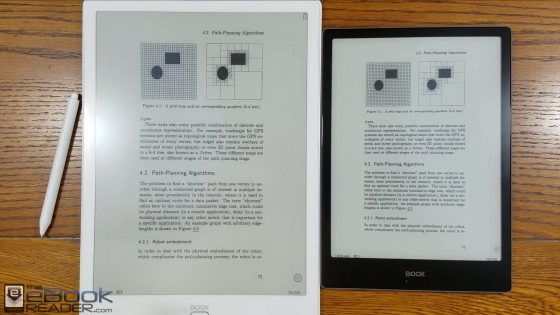The Onyx Boox Max3 is Onyx’s latest new device, their first to run Android 9.0, and it comes with some nice upgrades, but is it really worth $300 more than the Onyx Note Pro?
Both devices are largely the same from a software standpoint (especially once Onyx updates the Note Pro to Android 9.0). The main differences are hardware related.
To start with, the Onyx Note Pro has a 10.3-inch screen and the Max3 has a 13.3-inch screen, both E Ink Mobius Carta displays.
The Max3 has a PMMA-based front screen and the Note Pro has a glass front screen.
The plastic screen on the Max3 has a bit more friction when writing with the stylus, and it isn’t quite as reflective as the glass screen, but the differences are minor.
A big advantage for the Note Pro is the frontlight with adjustable color temperature; the Max3 has no light.
The Max3 comes with some upgrades over the Note Pro, including a fingerprint sensor, dual-band WiFi, and USB OTG support. Plus it has a micro HDMI port to use the device as a secondary monitor.
The Max3 also features an octa-core processor, but the Note’s quad-core processor seems to be just as fast if not faster when comparing both side-by-side. Perhaps the new processor has other advantages.
Both have 4GB of RAM and 64GB of storage space. Both have Bluetooth for connecting things like speakers and keyboards.
Both devices have capacitive touchscreens and Wacom touchscreens, and both come with a stylus pen. The Note Pro comes with a black stylus that has a side button to trigger the eraser. The Max3 comes with a thicker white stylus that has no side button, but you can still erase with the opposite end. Onyx sells them on Amazon for around $50 each, and while they say the white one is only for the Max3 it works perfectly fine with the other models.
Currently the Onyx Max3 runs Android 9.0 and the Onyx Note Pro runs Android 6.0, but Onyx has said the Android 6.0 models with get updated to Android 9 so they’ll soon be running the same software.
However, Onyx uses their own customized software so the Android version makes little difference and is virtually unnoticeable from a user perspective. It’s mostly just a marketing tactic at this point.
Conclusion
Both devices are basically mirror images of each other in regards to software features. It all comes down to the hardware differences, which size screen you prefer, how important a frontlight is, and if the extra features on the Max3 are worth spending $300+ more than the Note Pro.
Personally I’m going to stick with the Onyx Note Pro because I like having a frontlight, and for me a 10.3-inch screen is perfectly adequate for the PDFs I read, but the larger screen on the Onyx Max3 has some advantages when viewing two documents at once in landscape mode and when using the sidenote feature, and while the monitor mode function is a bit laggy it can still be useful for certain things.
Onyx Note Pro Review
Onyx Max3 Review Review (Pending)
Onyx Nova Pro Review
| Specs | Onyx Max3 | Onyx Note Pro |
|---|---|---|
| Screen | 13.3″ E Ink, 2200 x 1650, 207ppi with plastic front | 10.3″ E Ink, 1872 x 1404, 227ppi, with glass front |
| Processor | Qualcomm Octa-core 2.0GHz | Cortex-A17 Quad-core 1.6GHz |
| Wi-Fi | 2.4GHz/5GHz | 2.4GHz |
| Battery | 4300 mAh | 4100 mAh |
| Storage/RAM | 64GB and 4GB | 64GB and 4GB |
| Weight | 490 grams | 390 grams |
| Size | 309.8 x 227.8 x 6.8mm | 249.5 x 178.8 x 6.8mm |
| Frontlight | No | Yes, with warm and cool colors |
| Monitor | Yes, micro HDMI port | No |
| OTG support | Yes | No |
| Fingerprint sensor | Yes | No |
| Price | $859 at Amazon | $549 at Amazon |


Well I agree on the importance of the frontlight at least for me as I mostly use my note pro for reading.
There is no way I would ever go for another device without a frontlight for reading.
I keep hoping for a price break. At my income level I’d be a fool to spend so much on what’s basically a single-use device, even though it would help my eyestrain enormously.
Maybe it’s too hard to make big e-ink screens. Maybe companies need to go back to the drawing board to design a reflective screen that looks good in daylight, using some new tech instead of e-ink.